This page contains affiliate links. Please read our disclosure for more info.
I wanted Oman to be exotic. To not feel like anywhere else we’d been before (a challenge after eight years on the road). Maybe not quite slap-you-in-the-face India different, but pleasantly bewildering Japan different.
When we arrived at Muscat airport it did feel unfamiliar at first. The locals wear ankle-length gowns—white dishdasha with turbans for men and black abaya for women. The bathroom featured squat toilets and was a hectic mess of women chattering in Arabic.
Then we walked into the arrival’s hall and were greeted with a Costa coffee and WH Smiths, two British chains that we rarely see outside the UK.
Oman is a modern, wealthy country. It may have only gained its wealth with oil money in the 1970s and been closed to tourists until the 1980s, but in Muscat you can now find Pizza Hut and Starbucks and supermarkets stocked with all our favourite British chocolates, alongside the shiny mosques, bustling souqs, and simple Indian cafes.
I was a little disappointed by this at first. Muscat felt so easy and not really the exotic destination I’d hoped for.
Simon, on the other hand, took comfort in the familiar and happily gorged on bags of Minstrels and Toffee Crisp Bites, treats we hadn’t had for a year.
Despite its modernisation, Oman isn’t all chain restaurants and shopping malls, and we found that the further away from the towns we travelled, when Starbucks was replaced by basic coffee shops and goats grazed by the side of the road, the more we enjoyed it.
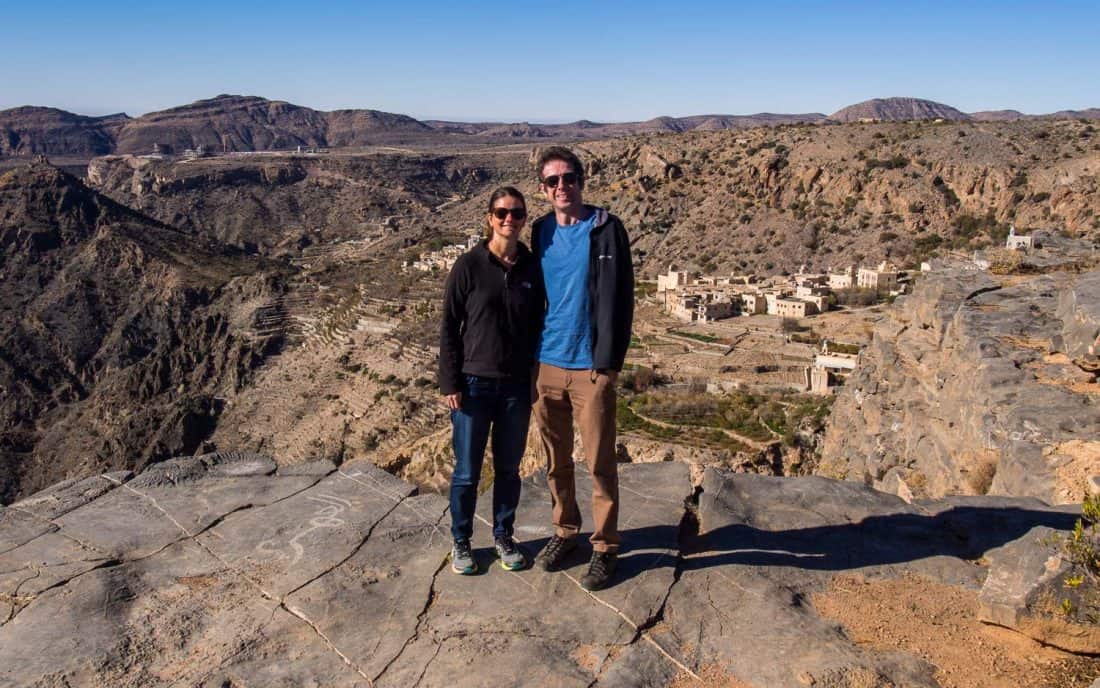
I find Oman harder to describe than other places we’ve visited, perhaps because we struggled to get under its skin on a short trip, perhaps because it has fewer obvious attractions than more popular destinations.
I have no snappy answer to the question of “what is Oman like?”, but here are our impressions after a 10-day road trip around the north of the country.
Video: Where to Visit in Oman
Where is Oman?
The Sultanate of Oman isn’t a well-known tourist destination so you might be wondering where exactly it is.
Oman is located on the Arabian Peninsula and shares borders with the United Arab Emirates to the northwest, Saudi Arabia to the west, and Yemen to the southwest.
Oman Travel is Safe and Easy
We found Oman an easy country to travel in, but you do need a car as public transport is limited.
Many people speak English; the roads are generally quiet, tarmacked, and in good condition; and crime rates are very low.
We felt totally safe in Oman and never worried about theft or scams or experienced any hassle.
Oman is one of the most stable countries to travel in the Middle East.
Muscat is not Dubai
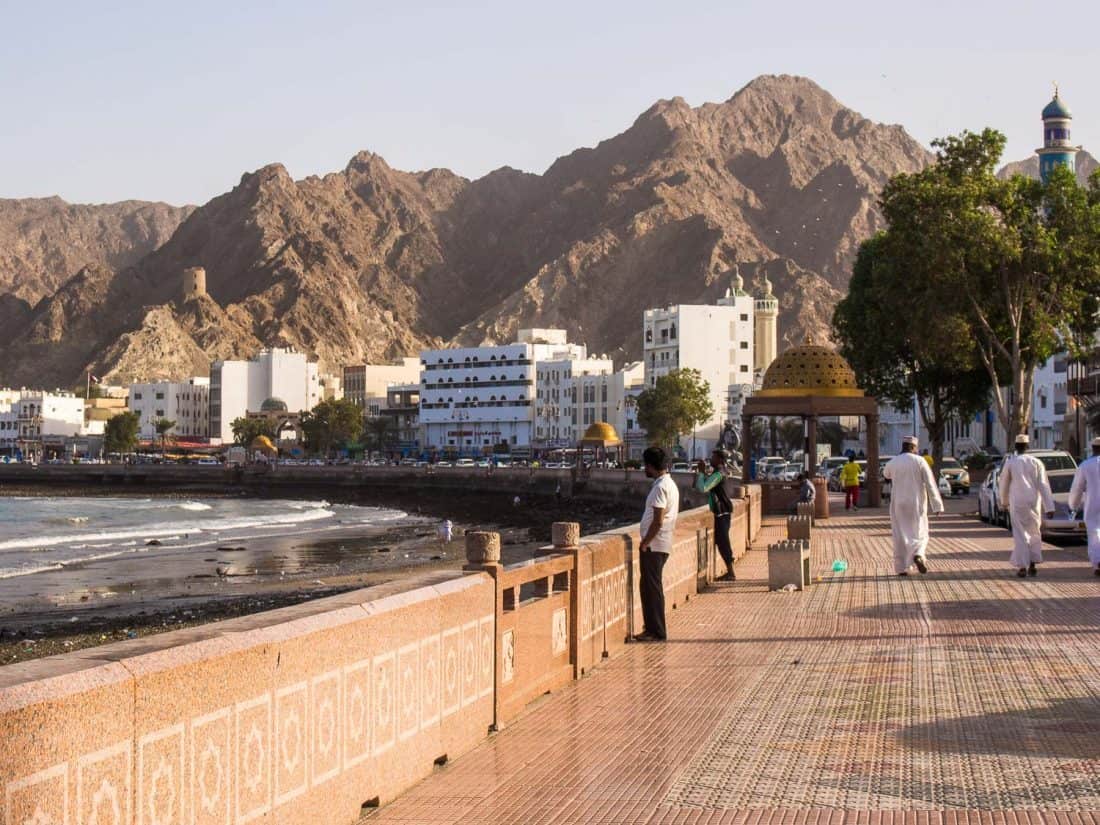
Despite the big highways and shopping malls, Muscat is a low key capital with none of the glitz or skyscrapers of neighbouring Dubai.
The city is very spread out between the jagged mountains and the sea.
The fancy houses, upmarket restaurants, and long stretch of beach of the diplomatic area Qurum feel very different to the cheap Indian restaurants, busy shopping streets, and medieval forts along the corniche of Mutrah.
There aren’t many major attractions, but the Sultan Qaboos Grand Mosque does live up to its name and is one of the best places to visit in Oman.
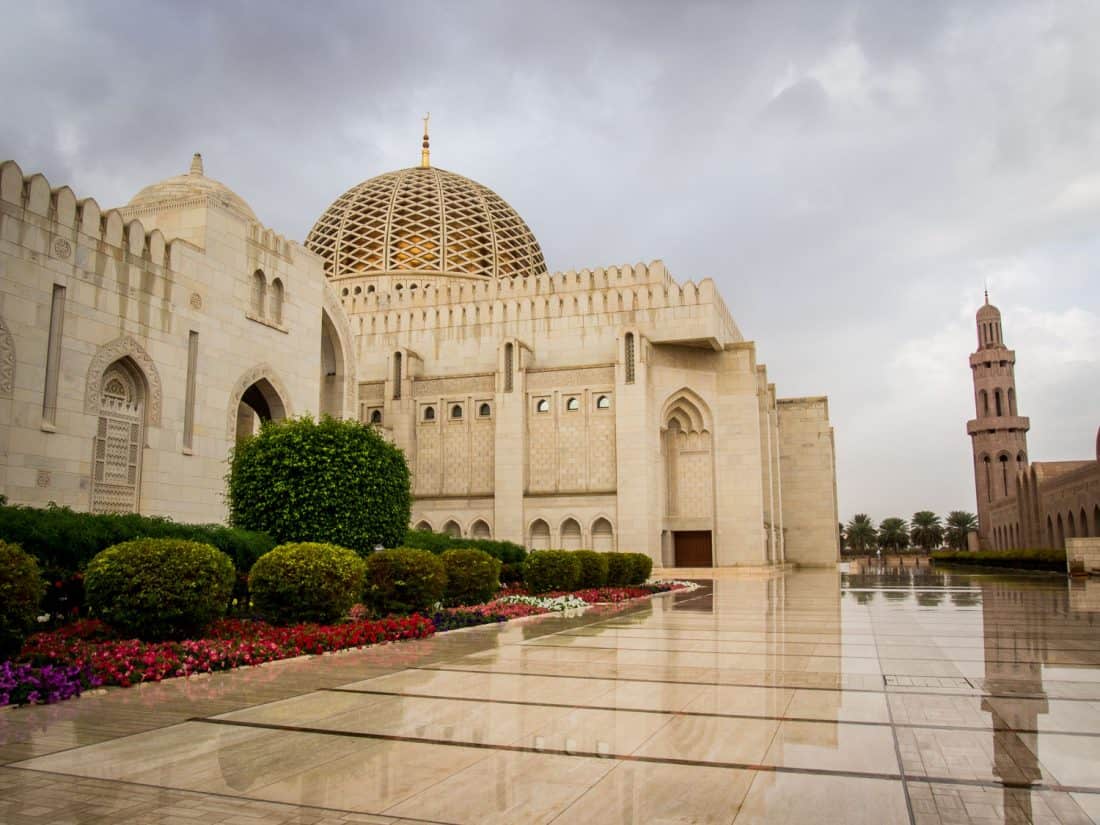
People
Oman is a Muslim country so you’ll see many mosques, hear the call to prayer five times a day (expect to be woken at dawn), and won’t find alcohol in most restaurants and shops.
46% of the 4.5 million population are expatriates, primarily from the Indian Subcontinent.
We found the people friendly but fairly reserved, especially the women who didn’t usually acknowledge us, while men in villages and on hikes would say hello. I wonder if this would have been different if I were travelling alone.
Oman is an absolute monarchy. When we visited, Sultan Qaboos bin Said al Said had been ruling the country since 1970—the third-longest reigning monarch in the world at the time.
He rose to power after overthrowing his father and proceeded to end Oman’s isolation and make huge changes to modernise and develop the country by building schools, hospitals, ports and a road and telecommunications network.
After his death in 2020, Haitham bin Tariq succeeded him as Sultan.
Landscape and Towns
Oman is 82% desert and we experienced it in many forms from the rolling dunes of Wahiba Sands to the rocky barren mountains around Nizwa and the sandy beaches of Sur.
Goats, camels and donkeys can be seen wandering by the side of the road in more rural areas.
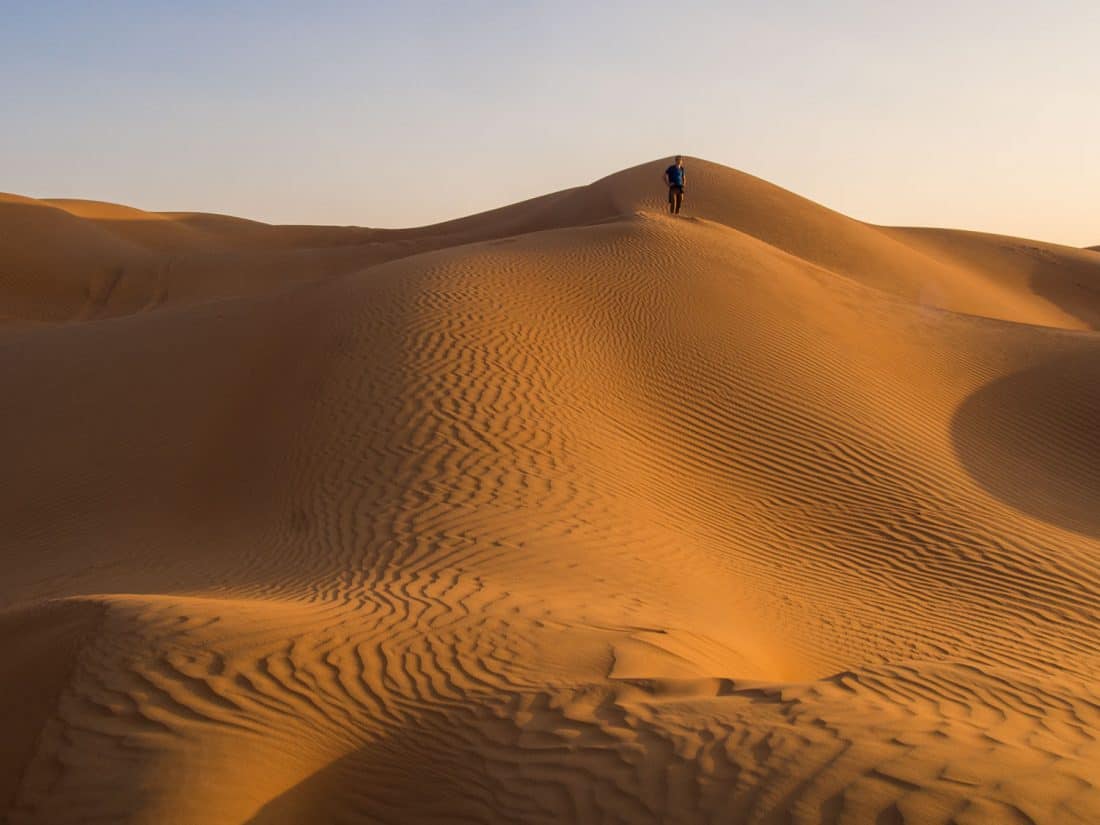
Most of the towns are fairly modern and not particularly attractive.
There are many old mud hut villages you can visit, but most have been abandoned and are in ruins. Misfat Al Abriyeen is one of the few that is still inhabited and is very picturesque.
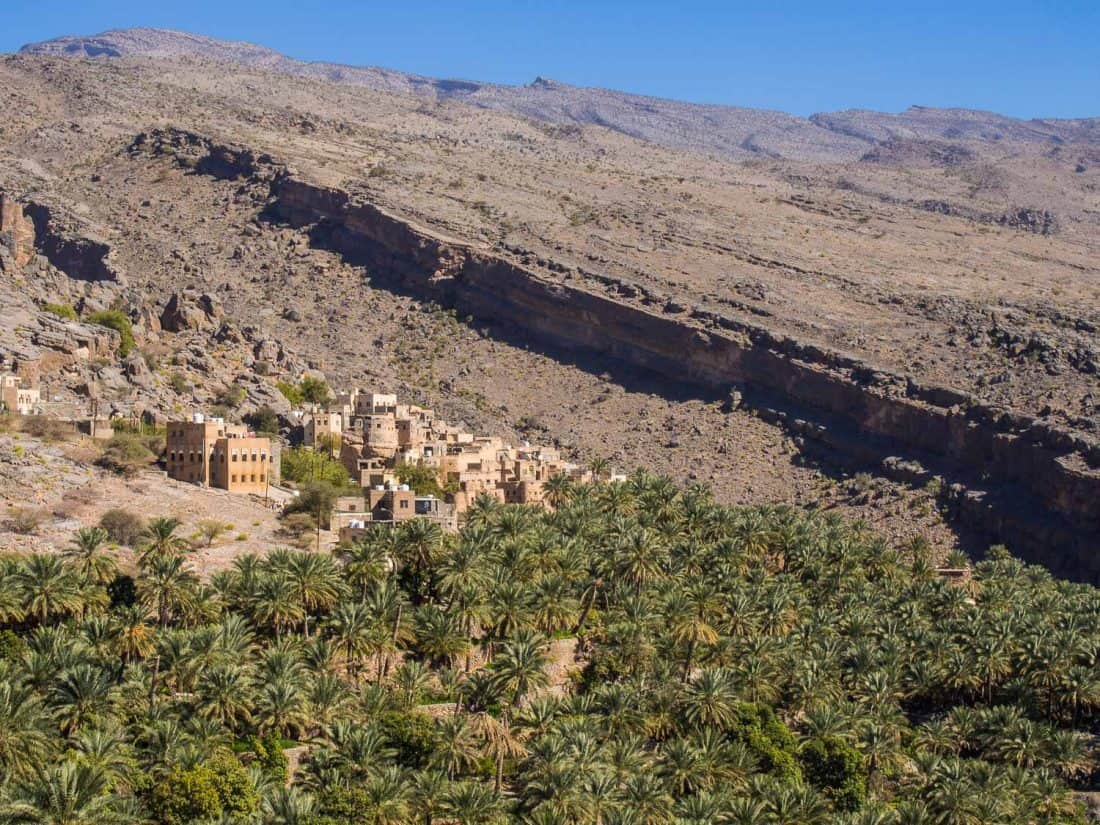
I loved the matter-of-fact shop signs in Oman proclaiming their purpose like “sell food stuffs”.
If you are a fan of forts, you’ll love Oman as every town has one of these sandcastle-like buildings, many hundreds of years old.
One of our favourite things about Oman was the oases that break up the bleakness of the desert with patches of vibrant green date palms.
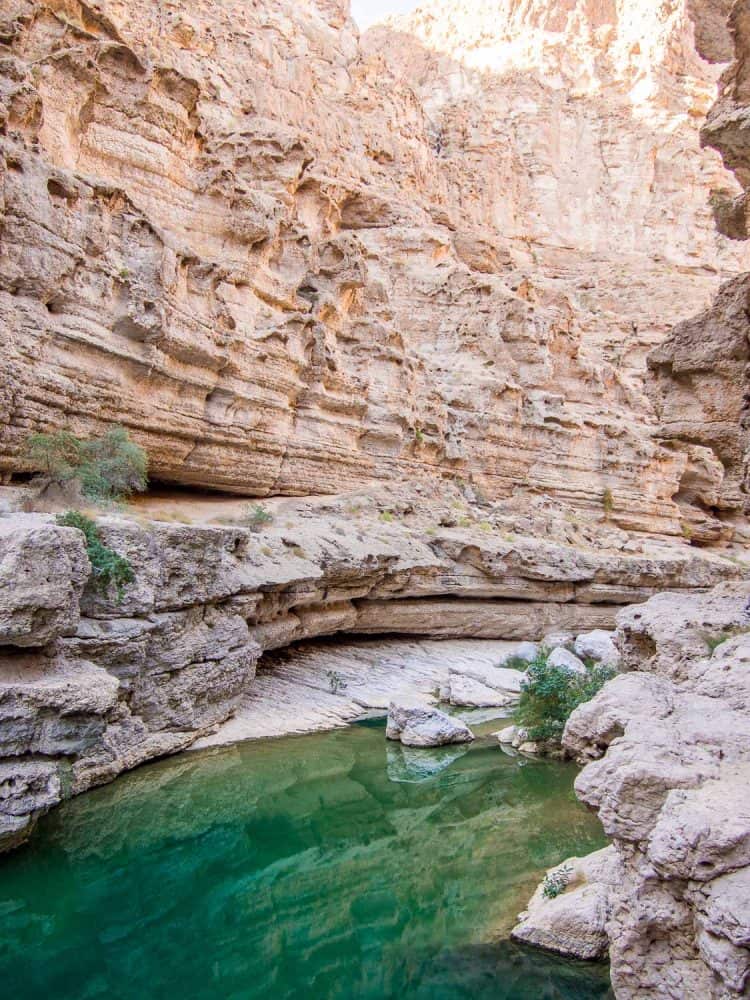
Some of the oases are found in wadis—dry ravines which sometimes contain glorious swimming holes of emerald water like at the lovely Wadi Bani Khalid.
Food
Oman doesn’t have a strong food culture and traditional Omani food mostly consists of meat and rice.
Despite this, it’s easy to be vegetarian as most restaurants serve either Indian food, where there is always dahl and vegetable curries, or Arabic/Turkish food with hummus, salads, flatbread and other mezze on offer.
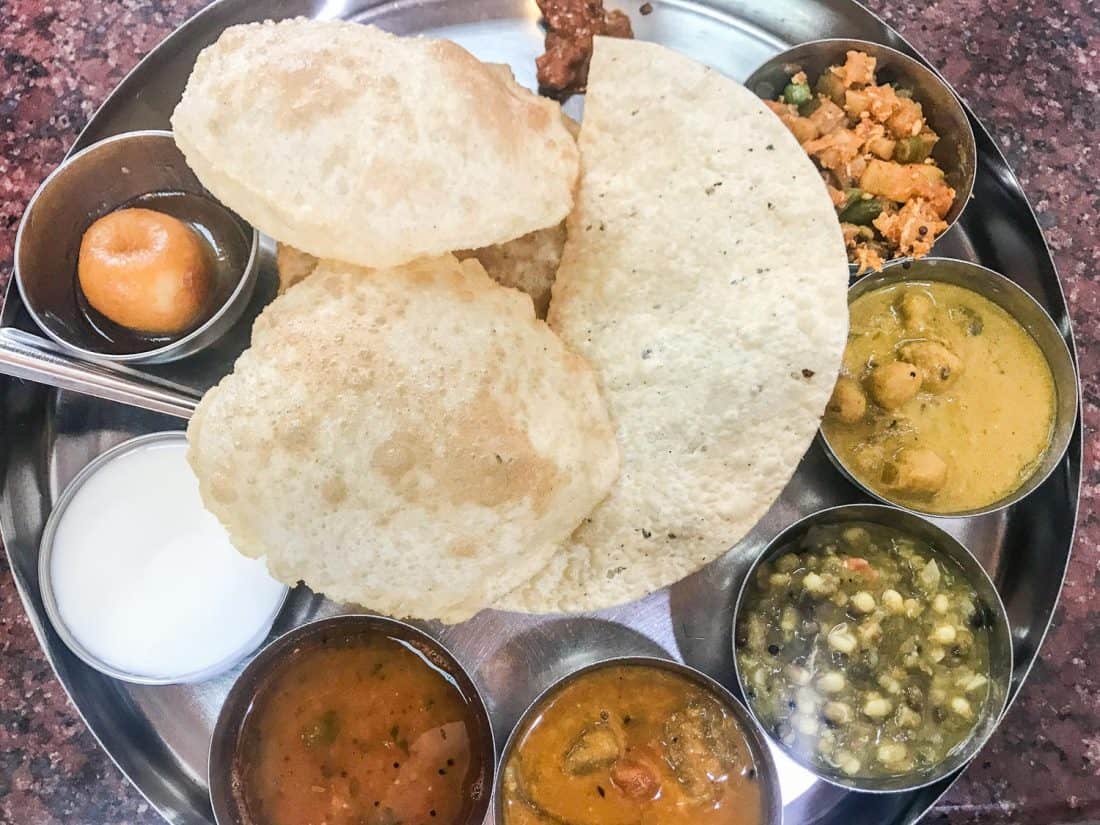
We were happy with the simple meals we ate, but it isn’t a foodie destination, and there aren’t many stand-out restaurants.
The most common place to eat is a basic coffee shop serving fast-food dishes with aspirational menus—they usually didn’t have everything on the menu but were happy to suggest vegetarian options for us.
Surprisingly, Oman does have fantastic supermarkets. We loved Lulu Hypermarket and when we had an apartment in Nizwa we self-catered from the prepared food section with dahl, curries, salads, hummus, bread and so much more. It was better and cheaper than most restaurants.
One culinary delight in Oman is dates, which are grown there. They are cheap and delicious and served with traditional Omani coffee in tiny cups.
It’s Quite Expensive
Oman has made the conscious decision to target the higher end travel market rather than backpackers.
Compared to India and SE Asia, we found accommodation particularly expensive, especially considering everywhere we stayed was functional rather than special.
The most interesting place we stayed was the simple but atmospheric Desert Retreat Camp in Wahiba Sands.
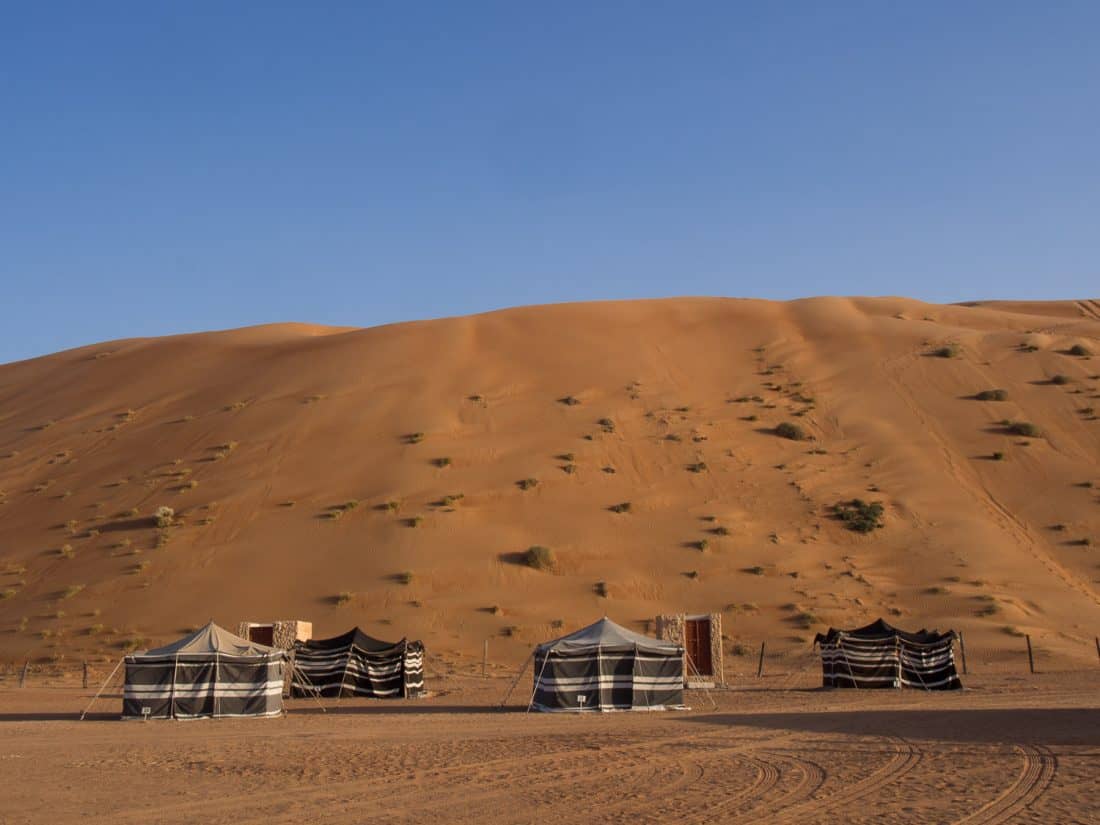
Some gorgeous new hotels are opening up as tourism increases, like the Alila Jabal Akhdar, but you have to pay hundreds of pounds a night for any style.
We spent £134 ($173/€145) a day for two people on our Oman trip with 51% of our budget on accommodation.
We found food inexpensive outside hotels and it cost us less than £14 a day (not including the meals that were included in two of our hotels), petrol is less than 40p a litre, and our favourite activities—hikes and wadis—were free.
The cheapest way to travel Oman would be to wild camp for free as it is legal in most of the country.
It’s Not Busy But Tourism is Growing
It’s easy to get off the beaten track when visiting Oman.
We visited in high season and travelled the most common tourist route, but there were still only a handful of foreign tourists at the major sights—usually older Europeans (British, French, German, Italians) travelling as a couple with a guide/driver or in small tour groups.
There was only one other guest at our desert camp and we had two of the most popular hikes in the country to ourselves by starting at 8am.
If you stray just a little from the popular attractions you’ll be the only foreigner around.
Tourism in Oman is growing, though, so now is the time to visit.
What to Wear in Oman
Locals dress modestly and it’s important that visitors do too when travelling in Oman.
There’s no need to cover your hair (except women when visiting mosques), but both men and women should cover their shoulders and knees.
In more conservative areas I preferred to cover my arms and legs too.
I usually wore linen trousers or jeans and a loose long sleeve shirt.
For swimming in the wadis, I wore cropped leggings and a baggy t-shirt over my swimsuit.
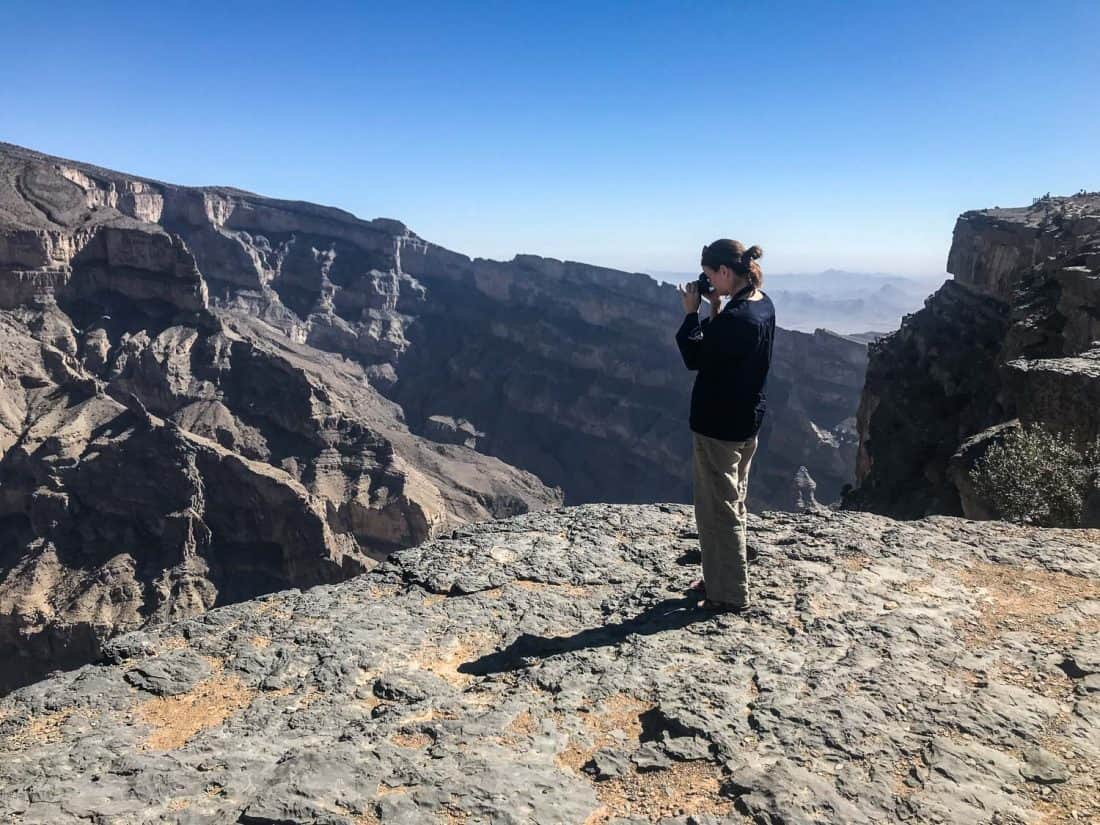
The weather in Oman in December was perfect—about 25ºC and sunny during the day, with cooler nights.
You do need warm clothes if you are going up the mountains—the nights on Jebel Shams were close to freezing.
Is Oman Worth Visiting?
Yes, we definitely recommend visiting Oman.
If it’s your first visit to the Middle East, I would probably recommend Jordan instead as it has more major sights and better food.
But if you are looking to get off the beaten track in a safe country Oman is a great choice. If you are a fan of desert, forts, wild camping, and adventurous 4WD trails, Oman would be perfect.
For inspiration, see my post on the most beautiful places to visit in Oman and for all the practical details, see our Oman itinerary.
If you enjoyed this post, pin it!
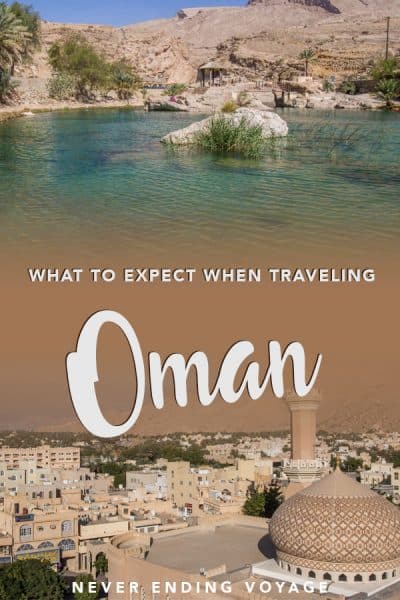
This post was originally published in 2018 after our first trip to Oman.
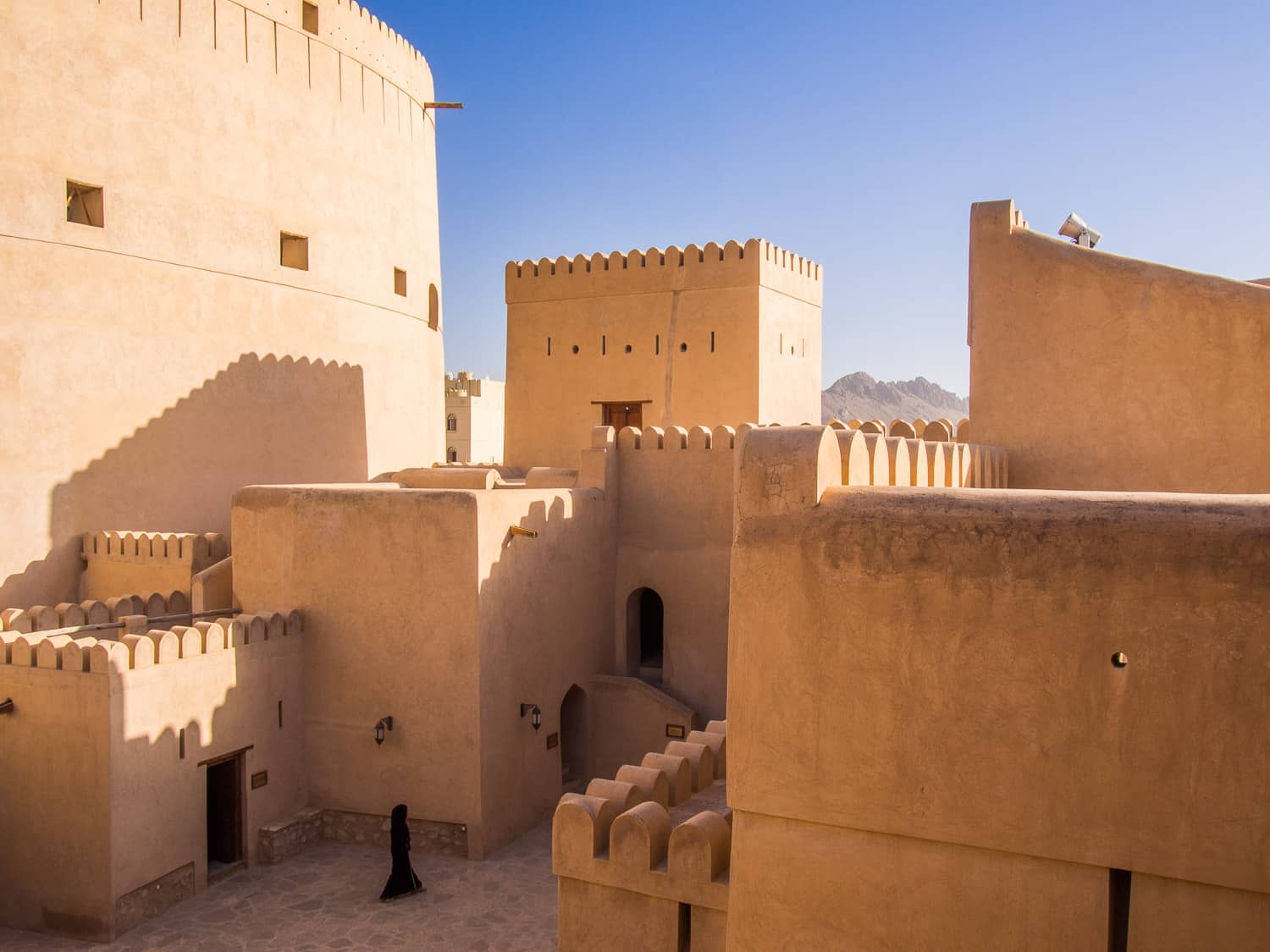
Great tips! I recently did a trip around Oman and really enjoyed it. In my opinion it is a beautiful country with just the right balance between tourist infrastructure and authenticity – at least for the time being.
I would particularly recommend Jabal Akhdar,
Bahla Fort, Wadi Bani Khalid and the Wahiba Sands. All very different places for a traveller to experience!
I’m so glad you enjoyed your trip to Oman, James!
Hi. Nice post! We will be visiting Oman and doing a self drive / camping tour. Im wondering if we will find any shower facilities along the way. Do you remember seeing some? Thanks
I don’t remember seeing any but we weren’t looking for them.
I have been to five middle eastern countries namely UAE, Oman, Qatar, Bahrain and Jordan. To be honest, Oman was my least favorite destination among all of them.
I liked the glitziness of Dubai, Abu Dhabi and Doha while also liking the ancient ruins, deserts, Wadi Rum and Petra of Jordan. But Oman felt extremely wierd to me. It seemed to be in this ugly spot where it neither had the glitz and glamour of the rest of the Gulf nor the authenticity of the other middle eastern countries like Jordan. Oman felt extremely rustic, shabby, run down and less developed than the Gulf while not having any of the good qualities that the non oil rich states have to offer. For instance, while being less developed, it certainly did NOT feel more ‘authentic’.
The real underrated destination in the region is Bahrain. I liked its perfect balance of tradition and modernity while there being so much to offer considering its super tiny size.
Thanks for your honest perspective. Bahrain is not somewhere we’ve considered visiting so we’ll definitely look into it.
You commented that “Oman doesn’t have a strong food culture and traditional Omani food mostly consists of meat and rice. ”
I lived in Oman for 23 years and I completely disagree, unless you are vegetarian then it’s another story. Omani food consist of various different types of food other than rice and meat.
“it isn’t a foodie destination, and there aren’t many stand-out restaurants.”
This comment perhaps stands out for other cities, however Muscat has so many restaurants with all cuisines such as Omani, Indian, Thai, Western ,Italian , Thai, Lebanese, Japanese etc….(including all the international chain restaurants)
We are vegetarian which does limit the Omani dishes we can try. That was just our impression on a short trip, so I’m sorry if you don’t agree. I’d love to hear your suggestions for fantastic Omani restaurants that visitors shouldn’t miss.
Hallo
nice and clear article to read!
We are planning to visit Oman in january and would like to ask your opinion:
Due to my job I do have the possibiliy to book a very good 4star hotel at a ridiculous price (more or less 40 euro x night with breakfast) but only staying inMuscat and salalah.
What if we stay 5 nights in Muscat and book 2 day trips to Nizwa and Wadi + 4 more nights at the beach in salalah? Could it work? Thanks valentina
Yes, they would be fairly long day trips (2 hours driving each way) but it’s doable.
The big festival in muscat is in January and I so recommend going during that time. All traditional cultural things in one place, great atmosphere.
I found Omanis very friendly, always helping and interacting with my family of young children. Children are loved for sure!
Omani coffee and Chai were delicious.
Waze was better than Google maps for driving, but most people will give you detailed directions when asked.
Outside of Muscat and wahiba sands area, we were the only westerners around and people would take photos and come talk to us.
It was very low key and an outdoors enthusiasts place to be.
Thanks for the feedback on your trip, Nic. Glad you enjoyed Oman!
Hello.
I’m diving off of a liveaboard boat in and out of the port in Muscat and wish to see some of the country as well. I have been in touch with some tour companies but the prices quoted are extremely high. I am a woman travelling alone and am considering renting a car. I will be there in late July and early August. Do most rental cars have GPS and is it the best option? You have repeatedly said it was safe and I think you will say that it would be for a solo female traveller but wish to confirm. I have been to Egypt and I speak a bit of Arabic. Should I go for it?
Thanks,
Debbie.
I would go for it! Although it will be very hot (head up to the mountains!). You usually have to rent GPS units for rental cars separately. It would be cheaper to get a SIM card for your phone (if unlocked) and just use Google Maps which is what we did. We bought an Omantel SIM card from the desk at the airport. More details in this post: https://www.neverendingvoyage.com/oman-itinerary-road-trip/
I’ve actually heard solo women have a great experience as local women are more likely to approach you (whereas they kept their distance from us because I was with a man). Have an amazing time!
Hello! I am an avid follower of your blog so was pleased to find that you have comprehensive article on Oman as I’m looking for winter sun somewhere different. Did you do much hiking when you were there?
Hi Becky,
We did the Balcony hike at Jebel Shams and walked/swam to Wadi Shab, both were beautiful! The details are in our Oman itinerary: https://www.neverendingvoyage.com/oman-itinerary-road-trip/
It’s a great spot for some winter sun! Enjoy! Erin
Hey , lovely blog, very informative and great Pics !! I am writing in from India, we’re a neighbor of Oman but i’ve not been there yet and was hoping to plan a trip , the landscapes are very inviting. However , I was wondering what would approximately be the per diem budget for daily expenses (flights, visa & hotels aside). E.g. touring around , F&B, entrances to sight seeing locations … roughly how much should be set aside ?? I am aware that its not really a cheap destination …
Hi Joe
I include details of our costs in our road trip itinerary post: https://www.neverendingvoyage.com/oman-itinerary-road-trip/
I hope that helps and you make it to Oman. It’s a beautiful country!
Erin
Yes it might be different had you been alone. I was in a group of four, all ladies. One of us stayed behind at Wadi Bani Khalid while the rest of us hiked up it. She was promptly adopted into an Omani family picnic while we were gone.
That is interesting. I think Simon’s presence made it impossible for the local women to talk to us much.
Great articles. I’m going to Oman for a few days this month, so very helpful. Thanks
Have a great trip!
Well you started out with describing how Oman failed your expectation of being ‘exotic’, but the more I read on the article, the more I felt as if I am getting to know a truly exotic place! Thank you for the honest and beautiful take on Oman!
I have been living in Oman for 7 months now. Not in Muscat but in Nizwa and it does feel VERY different from Western life – in terms of habits and values.
Thank you for sharing about Oman. I love the sands! Do you think it is safe to free camp?
Definitely! Oman feels extremely safe.
Fantastic info guys. Thanks for your detail and honesty. It’s easy to say ‘I’d love to go anywhere and everywhere’ but your reviews give us food for thought about picking our next destination. Cheers.
I’m glad it helped Stephen!